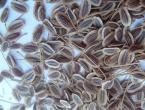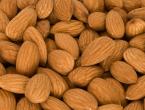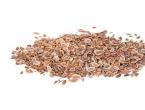How to germinate amaranth for food. Sprouted amaranth: properties and features. Useful properties of amaranth
Amaranth pleases not only with its delightful beauty, but also with useful properties. How to grow amaranth from seeds at home?
How to get seeds
Amaranth seeds can be purchased at any specialty store, but many prefer to grow from their own plants. Their seme can be obtained in this way:
- It is necessary to cut the panicles at the very base and lay them out on a flat surface (you can use a table). For 2 months they dry well, while the room where they are located should be dry. It should also be ventilated.
- After drying, the panicles should be sieved through a sieve with small cells.
- Seeds obtained after sifting should be left in the same room for up to 10 days. They should be stirred occasionally.
The resulting seeds are folded into paper envelopes. In this form, they can be stored for up to 4 years.
So that rodents do not get to the seeds, during drying, elderberry branches can be spread around.
How to germinate seeds
After the seeds have been collected and dried, they should be germinated. You need to do this in the month of March in this way:
- The first thing to do is prepare the ground. Mix humus and sterile sand in a ratio of 3:1. To avoid fungus and pests, the soil must be warmed up.
- The container in which the seeds should be placed should not be lower than 10 cm. For this, you can use both pots and wooden boxes.
- Holes must be made in the container so that excess moisture can escape.
- When planting, seeds should be placed at a depth of 1.5-2 cm. After that, cover the container with a film.
- After the seedlings germinate, they need to be thinned out. It is necessary to leave only strong and healthy sprouts.
Watering amaranth should be done carefully, too much water can lead to rotting. It is best to use a spray bottle. If the temperature in the room where the seed boxes are located is 22 ° C, germination will occur already in 3-4 days.
After the appearance of several leaves, the seedlings need to be planted in separate containers. You can plant amaranth in open ground when the temperature is stable within 4 ° C. The earth at this moment is warm enough, so there is no risk that frost will hit.
Before planting in the ground, it should be fertilized. And it's good if it's a sunny place. Also, before planting, seedlings should be put outside for 2-3 hours for 3-4 days. Thus, adaptation to a new place takes place.
You may also like:
 Cladrastis - cultivation, propagation, planting and care
Cladrastis - cultivation, propagation, planting and care  Abelia - cultivation, reproduction, planting and care
Abelia - cultivation, reproduction, planting and care  Aralia - cultivation, reproduction, planting and care
Aralia - cultivation, reproduction, planting and care  Kuril tea - cultivation, planting, reproduction and care
Kuril tea - cultivation, planting, reproduction and care  Laurel cherry - planting, propagation, cultivation and care
Laurel cherry - planting, propagation, cultivation and care  Pteley - growing, planting, reproduction and care.
Pteley - growing, planting, reproduction and care.
The first mention of the cultivation and use of amaranth (shiritsa) appeared more than 7 thousand years ago. It was used as a remedy, the Aztecs in South America prepared food and drinks from its grains. In Rus', this product was very popular for a long time, but over time, interest in it faded somewhat. Currently, more and more people are striving to get substances from the gifts of nature that will support immunity and improve health. Amaranth belongs to such a plant.

Composition and properties
This plant can be called unique, since all parts of the plant have useful and healing properties. Amaranth seeds are used in cooking, you can make porridge from them, add them to sauces.
The leaves of the plant are used in agriculture as a fodder crop. They are used as additives to dishes, put dried leaves in tea. Leaves of culture can be prepared in advance. They are dried, pickled or frozen in the freezer.
No less valuable is amaranth oil. It is used as a tonic, the product helps to restore the immune system, has anti-inflammatory and analgesic effects. It is used as a therapeutic and prophylactic agent for many diseases. This is the perfect skin care product. Amaranth oil is used in cooking.
When adding it to dishes, it must not be heated, otherwise the product will lose its beneficial properties during the heat treatment.
In terms of its nutritional properties and therapeutic effect, amaranth oil is very similar to olive oil.

Amaranth grains are also used for sprouting. Sprouts will bring great benefits when they are consumed, besides, they will enrich the dish with valuable components and give it a delicate taste. To germinate, the grains are soaked for 12 hours, then the water is drained and left in a humid environment for 1-2 days until the grains begin to germinate. The optimum temperature for germination is 36 degrees Celsius. After the appearance of the sprouts, they are subjected to heat treatment, starting from 60, 75 and ending with a temperature of 95 degrees Celsius. The time spent in the oven is 1 hour. After that, the grains are crushed.
The chemical composition of the plant is unique. It contains the necessary components for the body. It contains vitamins A and B, also C and K, vitamin PP, in addition, there are flavonoids, tocopherol.

Amaranth seeds contain an important element of squalene, thanks to which aging can be delayed for a long time. Squalene is necessary for the synthesis of vitamin D. To make it better absorbed, it is recommended to introduce it into the diet with ripe fruits.
Amaranth contains a large amount of minerals, such as magnesium, sodium, calcium. In addition to them, iron, selenium, manganese, zinc and phosphorus are present in sufficient quantities.
The calorie content of the product is low, 100 gamma seeds contain about 370 kcal. Protein in amaranth contains 13.6 g, which is 15%, fat contains 7 grams (7%), and carbohydrates 68.6 grams, which corresponds to 74%.

In addition, the composition contains:
- water -11.3 grams;
- fiber 6.7 g;
- ash - 2.9 g.
Amaranth contains pectin, starch, proteins, as well as an important component of lysine. It is contained in flour from amaranth seeds more than in wheat, almost 30 times. Thanks to it, the component improves the absorption of protein. This product perfectly combines vitamins, minerals and other important components.

Amaranth seeds should be included in the daily diet, as they have unique properties.
- The seeds contain fiber, thanks to which the body is cleansed of fatty deposits and which helps to collect and remove toxins from it.
- The presence of a large amount of protein allows you to not feel hunger for a long time and at the same time not to overeat.
- Seeds should be used for eye diseases. Their regular use serves as an excellent protection and prevention of cataracts, dystrophic changes in the retina.
- There is no gluten in amaranth seeds, so the product should be used by patients with intolerance to this component.
- It is worth including it in the menu for patients with diabetes.
- The presence of peptides in the plant helps fight inflammation in the body.
- Seeds have an immunostimulating effect, they should be included in the diet for the prevention and treatment of cancer.
It should be used for diseases of the genitourinary system, hemorrhoids. It will also help with nervous diseases, overwork, nervous exhaustion, stress. This plant has long been used for the treatment and prevention of many diseases in many countries.

Features of use
Although amaranth seeds have a specific smell that may not be to everyone's taste, it should definitely be included in the diet for those who want to be strong, healthy and young. Seeds, amaranth flour, as well as the most valuable oil from this product are used for food.
Before use, amaranth grain flour should be kept in the oven at a temperature of 100 degrees for 10-12 minutes.
Seeds can also be eaten raw, but it is better to subject them to heat treatment, for example, put them in boiling water for a couple of minutes. If the seed is consumed raw, there may be a decrease in the absorption of valuable nutrients.

Healthy porridge can be cooked from amaranth seeds. They can be ground in a coffee grinder and used as meal, adding in small quantities to pastries, as well as for breading fish and meat dishes. Shiritsa is even used for popcorn.
It is better to eat seeds on the same day, the daily norm is 100 grams. And the daily norm of oil from it is about three tablespoons. Leaves from the plant are added to tea.

Collection and germination
Considering how valuable this product is, many recommend germinating the seeds. If you use them for germination, after 1-2 days you can get sprouts that have a unique benefit for the body. In sprouted form, the content of vitamins in them increases five times.
Amaranth seeds can be germinated for eating at home.
To get valuable sprouts, you should:
- pour the grains into a jar and fill them with water so that the water only slightly covers them;
- in this form, the container is left in a warm place until the sprouts begin to hatch;
- after that, the jar is placed in the refrigerator until the sprouts are completely germinated.

Raw foodists recommend eating sprouts for two months, then take a break, and repeat the course if desired. It is better to include them in the diet in the morning. This will give you the opportunity to recharge your batteries throughout the day. Taking them in the evening can cause insomnia.
Store the germinated product in a container with a lid that is not tightly closed. Do not keep sprouts in the refrigerator for more than four days. If soured or unsprouted grains appear in the container, they must be removed.
During breakfast, you should eat 1 tbsp. a spoonful of sprouted sprouts, add them to a salad during lunch.

cooking recipes
Amaranth seeds are used to prepare many dishes, they are added to smoothies and drinks. You can make sweet porridge from shiritsa. For her, you need to take the following products:
- amaranth seeds - one spoon;
- water - two glasses;
- sugar or honey;
- butter or vegetable oil.
To prepare porridge, the grains should be washed, poured with boiling water, then drained. Pour 2 cups of water into a saucepan and add a glass of seeds. After the water boils, you should cook the dish for another half hour. 5 minutes before the end of cooking, sugar or honey is added to it. The finished dish is seasoned with a piece of butter.

fish cakes
Required components:
- fish (fillet) - 60 -70 grams;
- amaranth meal - 2 tablespoons;
- one carrot;
- bulb;
- a piece of stale bread;
- 30-50 ml of milk;
- salt and spices.
To prepare juicy cutlets, fish fillets and vegetables are passed through a meat grinder. Flour, spices, milk are added to the mixture. A piece of butter is placed inside each cake and a cutlet is formed. After rolling them in breadcrumbs, the cutlets are fried in a pan. Then the cutlets are put on a baking sheet and sent for a few minutes in the oven.

Vegetable cutlets
Ingredients:
- 3-4 potatoes;
- one carrot;
- green peas - 30 grams;
- whole grains of amaranth - 40-50 grams;
- one egg;
- breadcrumbs for breading;
- vegetable oil;
- spices, herbs.
Vegetables are peeled and boiled until cooked, then green peas are added to them. Everything is placed in a blender and ground. Pour the amaranth seeds into the vegetable puree, mix the mass.
Cutlets are formed from the finished mass, roll them in breadcrumbs and fry over medium heat. It is better to serve the finished dish with sour cream.

Sprouted grain is a storehouse of useful substances. It doesn't matter what kind of cereal - wheat, rye, oats, flax. You can even sprout lentils, chickpeas, and mung beans. All of them will benefit the body. Amaranth is no exception. But many adherents of a healthy diet have problems with it. The fact is that small seeds, such as poppy and amaranth, are difficult to germinate - they very quickly become covered with mold, and all efforts are wasted. And with them, the desire to keep going.
But don't give up. It is quite possible to germinate amaranth seeds for food. The main thing is to be patient and have the necessary kitchen utensils, since conventional methods will not help here.
Order 5 packs and get another one for free!Price: 110 rub. In the basket 0 units
Sprouting method: how to get a useful product correctly and without much effort
To properly germinate amaranth seeds for food, you will need:
- high-quality calibrated seeds for food purposes;
- sieve;
- deep basin, suitable in diameter to the sieve;
- nut milk bag.
Soak the seeds in water. Some of them ozonize, but not everyone in the house has the appropriate device. Then spread a thin layer on a nut milk bag and place in a sieve. Do not use gauze. Small roots will get tangled in them very quickly, and it will be quite difficult to collect grains from it. But such a bag of fine mesh will be very handy.
When the water drains, install the sieve in the basin. Rinse amaranth seeds once a day, carefully watering them with water. In a few days, excellent sprouts without smell and mold will be ready.

How to store and use sprouted amaranth seeds?
You can use them in different ways. Someone makes rejuvelac (a vitamin drink from cereals), others just eat a teaspoon with honey or vegetable oil. Such seeds can be added to vitamin salads, and if dried in an oven at 40 ° C and ground into flour, then excellent breads and cookies are obtained from it. In addition, this flour can be added to cereals, soups and smoothies.

You can store sprouts in the refrigerator. But there are a few more little-known ways. For example, canning. At the same time, sprouted amaranth seeds do not lose their beneficial properties at all, but are stored much longer.
Grains are preserved on the 5th day of germination. It is at this time that the maximum amount of useful substances accumulates in them. First, the seedlings are disinfected, then washed and dried. Then they are mixed with honey in a ratio of 1:4 and also stored in the refrigerator, but much longer than unprocessed grains.
Rules for the use of sprouts: instructions for beginners
Despite the fact that there seems to be nothing complicated in the use of sprouts - I took it and ate a spoon - there are several rules:
- for the first couple of months, consume sprouted grains no more than five times a week;
- do not eat sprouts at night;
- in no case should seeds covered with mold be eaten;
- strictly observe the dosage;
- thoroughly chew the sprouts or grind before use, so they are better absorbed;
- try not to heat treat;
- best mixed with vegetable oil or honey.
By following these simple rules, you can notice how well-being and mood improve in a very short time. And this is just the beginning!
I didn’t order Amaranth and didn’t know anything about it at all until I found this package in one of the parcels. I thought: "oooh, probably a gift to me from iherb"))) but it didn’t happen ... The package did not contain the ordered promotional tea, apparently they decided to make such a strange replacement)
He stood for a couple of months in the kitchen, and finally I got around to learning more about him and finding a use for him. It turned out to be a very interesting and incredibly useful product...
Amaranth was introduced into culture by the peoples who inhabited Central and South America more than five thousand years before the New Era. The Aztecs and Incas, the Indians of Guatemala and Peru prepared a wide variety of dishes from amaranth seeds, used them in medicine, as well as in religious rites. Amaranth for the Indians was a sacred plant.
The renaissance of amaranth began in the 1970s, when Australian physiologist John Downton discovered that amaranth seeds are rich in protein with a very high content in it. lysine- the most important essential amino acid, deficient in the proteins of the seeds of cereal plants. Currently, amaranth is cultivated all over the world and is recognized by UNESCO as the main food crop of the 21st century.
The benefits of amaranth seeds
Amaranth seeds contain a record amount squalene.
Squalene gets its name from the Latin name for the shark, squalus. It was in the liver of this predatory inhabitant of the depths that at the beginning of the last century, Japanese scientists discovered a curious chemical compound. The study of the many useful properties of squalene continues to this day, but its already discovered talents are enough to understand the benefits of caring for a sufficient intake of squalene with food or pharmaceutical preparations. Squalene fights cancer cells, preserves youth, supports immunity, improves the functioning of the heart and hormones. It is also non-toxic and safe at any concentration.
The beneficial properties of amaranth, whose very name means "immortal", were known to many ancient peoples, including the Slavs and the original population of America. Amaranth contains unsaturated fatty acids, calcium, magnesium, iron and, as it turned out, also squalene (a record 8% in the oil pomace from seeds). It has been proven that amaranth oil actively counteracts the formation of cancer cells; it is also used for skin diseases, burns, ulcers, eczema.
How to use amaranth seeds?
Amaranth is gluten free!
What can be done with amaranth: for example, boil porridge, add to soups, soak for a day to soften and eat raw, adding to porridge, for example, or to cottage cheese. In size, amaranth seeds are even smaller than poppy seeds.
You can grind in a coffee grinder to the consistency of flour and add anywhere just like ground flax seeds.
How to germinate amaranth from seeds?
Amaranth sprouts are also extremely useful. They are very active in synthesizing antioxidants during germination. On the fifth day, the total content of antioxidants increases by 20 times compared to dry seeds. This testifies to the active health-improving effect of amaranth seedlings.

Rinse the seeds, disinfect with a weak solution of potassium permanganate, rinse again properly, and leave in a plate with a small amount of water, cover with a lid with a small hole, rinse twice a day, sprouts appear on the second or third.
Store sprouts in the refrigerator at a temperature of 6-8 degrees. Take daily in the morning for 15-20 grams.
You can grow the leaves and add them to the salad

I looked for amaranth in Moscow, I was surprised by the prices, 2-2.5 times more expensive than Aikherbovsky ... So I will definitely take more.
For the human body is colossal. Here are some of its useful properties:
- strengthens the cardiovascular system;
- improves metabolism;
- suppresses inflammatory processes;
- strengthens the immune system;
- balances the hormonal system;
- has a diuretic effect;
- promotes hematopoiesis;
- cleanses the body of radionuclides;
- helps fight tumors;
- returns sexual activity to men;
- the most powerful antioxidant (thanks to squalene - more on that below).
This culture has been used by man for medicinal and nutritional purposes for 8 thousand years. At different times it was called: “bread of the Incas”, “wheat of the Aztecs”, and the ancient Indians praised amaranth as the food of the gods. Amaranth (from Greek a - a particle of negation, marainein - to fade) - means “unfading”, “giving immortality”. Indeed, legends do not lie, which has already been proven by numerous scientific studies in our time.
One of the recent fundamental discoveries in the field of health was squalene.
This is a powerful antioxidant, the basis of the processes of slowing down aging and prolonging life. Previously, it was extracted from the liver of oceanic sharks that live at great depths. But the process of extracting the antioxidant was extremely expensive and produced a relatively small yield of squalene. Everything fell into place when scientists turned their attention to amaranth. There are many times more useful substances in it, and in the process of obtaining there is no need at all, because amaranth is useful in any form: from seeds to leaves.
The benefits of amaranth for humans are obvious, there is a lot of publicly available information on this topic. Another question is the benefits of sprouted amaranth.
The fact is that in seeds that have not been subjected to any type of treatment (neither thermal nor mechanical), all useful substances are literally “preserved”. In the process of seed germination, such a nutritional set is “printed out” and the healing properties of amaranth are greatly enhanced. That is, germinated amaranth is the most useful.
But that is not all. This plant reaches the peak of its abilities if it is germinated on microgreens: in this case, a living healer reveals and gives a person all his potential.
Amaranth seeds, benefits and harms and how to take
Despite the significant benefits of amaranth, it is worth mentioning the possible harmful component of the plant. Like any product, it can cause allergic reactions or individual intolerance. It's worth checking it out on a small dose. It is always worth starting to take amaranth with small amounts: 1 tbsp. sprouts per day. It is not recommended to take amaranth for patients with pancreatitis, cholecystitis, urolithiasis and cholelithiasis.




